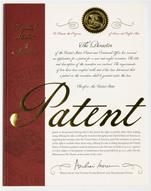© 2018 The Texas Lawbook.
By Natalie Posgate
(June 19) – A group of Dallas lawyers from Munck Wilson Mandala made patent history Tuesday by securing a laser detection technology patent for Raytheon. It was assigned Patent No. 10,000,000 by the U.S. Patent and Trademark Office.

“This will be a fun fact about U.S. patent history that we are a part of and we get to share with our client Raytheon, a true national treasure,” said William Munck, who helped Raytheon and inventor Joseph Marron secure the historical patent with the U.S. Patent & Trademark Office. “We are excited for Joe and the Raytheon team. This is a marker in U.S. history.”
Others on the Munck Wilson IP team included partners David Doyle and Dan Venglarik.
Patent No. 10,000,000 deals with laser detection technology that could prove vital in products like autonomous vehicles, medical imaging devices, military defense systems and space and undersea exploration.
Doyle explained that Raytheon’s patent increases the capabilities of LADAR systems, which “operate by transmitting laser signals toward a target and processing laser signals reflected from the target.”

Patents have been issued continuously since 1790, when the Patent Act was passed, which created a patent system described by the Founding Fathers in the U.S. Constitution as a federal agency to “promote the progress of science and useful arts.” The first patent board comprised Secretary of State Thomas Jefferson, Secretary of War Henry Knox and Attorney General Edmund Randolph.
George Washington issued the first patent in 1790 to Samuel Hopkins for potash, an ingredient used in fertilizer.
While it took more than 121 years in the USPTO’s history for the first million patents to be issued, the USPTO issued the same number of patents in a four-year span from 2011 to 2015 (8 million to 9 million).
“Each patent represents countless hours of trial and error, persistence and fortitude from the inventors to bring the idea to fruition,” Doyle said. “[Patent No. 10,000,000] represents a tremendous milestone for both the USPTO and the history of American innovation.”
But according to the history of the USPTO, Patent No. 10,000,000 doesn’t exactly represent the 10 millionth patent.
The 1836 Fire and the “X-Patents”
The first physical location of the USPTO was established in 1810 in the Blodget’s Hotel in Washington, D.C. The U.S. Patent Office was later renamed the U.S. Patent and Trademark Office in 1975.
According to the USPTO’s website, there had been approximately 9,970 patents issued between 1790 and 1836, when a raging fire destroyed the building in which the agency had been storing nearly 10,000 patents issued to that point. Ironically, when the fire occurred, the Patent Office was in the process of constructing a new, more fireproof building, said Thompson & Knight attorney Justin Cohen, who has studied the history of 1800s patents.
Cohen said after the office burned, the Patent Office did its best to recreate records by obtaining copies from the original inventors, and 9,957 is the closest number it came back with. The Patent Office did not have a formal numbering system before the fire, so patents were identified by titles and dates.
Because the Patent Office re-started the patent count after the 1836 fire, there could not be two Patent No. 1’s or Patent No. 9,957’s in the system, Cohen said. To solve this issue, the Patent Office added an “x” to the titles of the patents issued between 1790 and the 1836 fire. The patents issued in that time period are known today as the “X-Patents.” Only 2,845 of the 9,957 missing patents were fully-restored.
Cohen said he learned about this history while interning earlier in his career at Michigan IP law firm Reising Ethington, which was established in 1865. Cohen was asked to look into early 1800s patents that the firm founders had been involved in.
“It’s really interesting history,” Cohen said. “Issuing Patent No. 10 million is a huge milestone. It’s incredible and it’s fascinating. The other part of our history of what is the technical 10 millionth patent leads to this interesting history of the origination of the USPTO and the 1836 fire.”
To learn more about the history of patents in the U.S., visit this fascinating website created by the USPTO.
(Editor’s Note: This article has been updated to include the history of USPTO’s “X-Patents.”)
© 2018 The Texas Lawbook. Content of The Texas Lawbook is controlled and protected by specific licensing agreements with our subscribers and under federal copyright laws. Any distribution of this content without the consent of The Texas Lawbook is prohibited.
If you see any inaccuracy in any article in The Texas Lawbook, please contact us. Our goal is content that is 100% true and accurate. Thank you.
